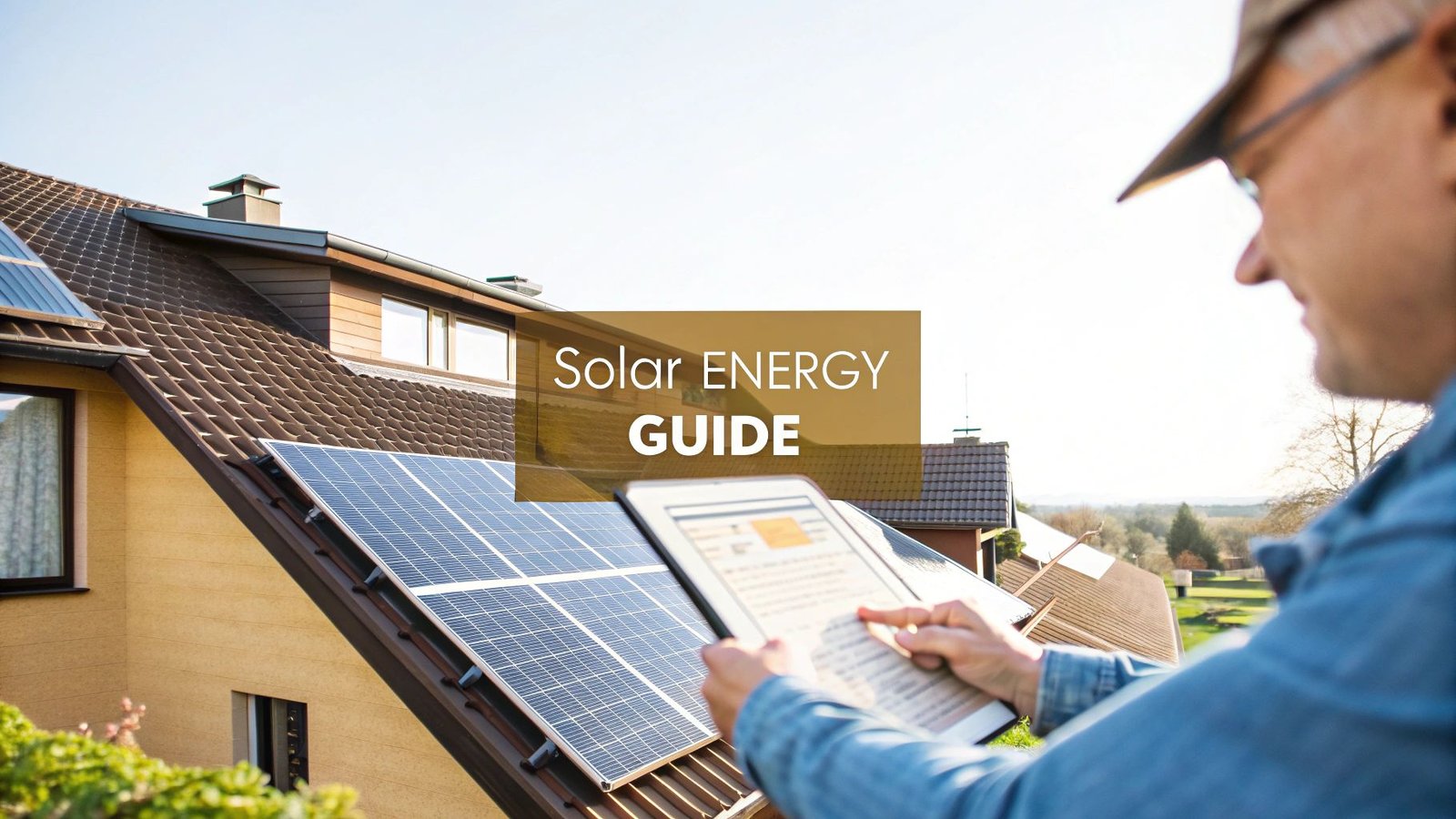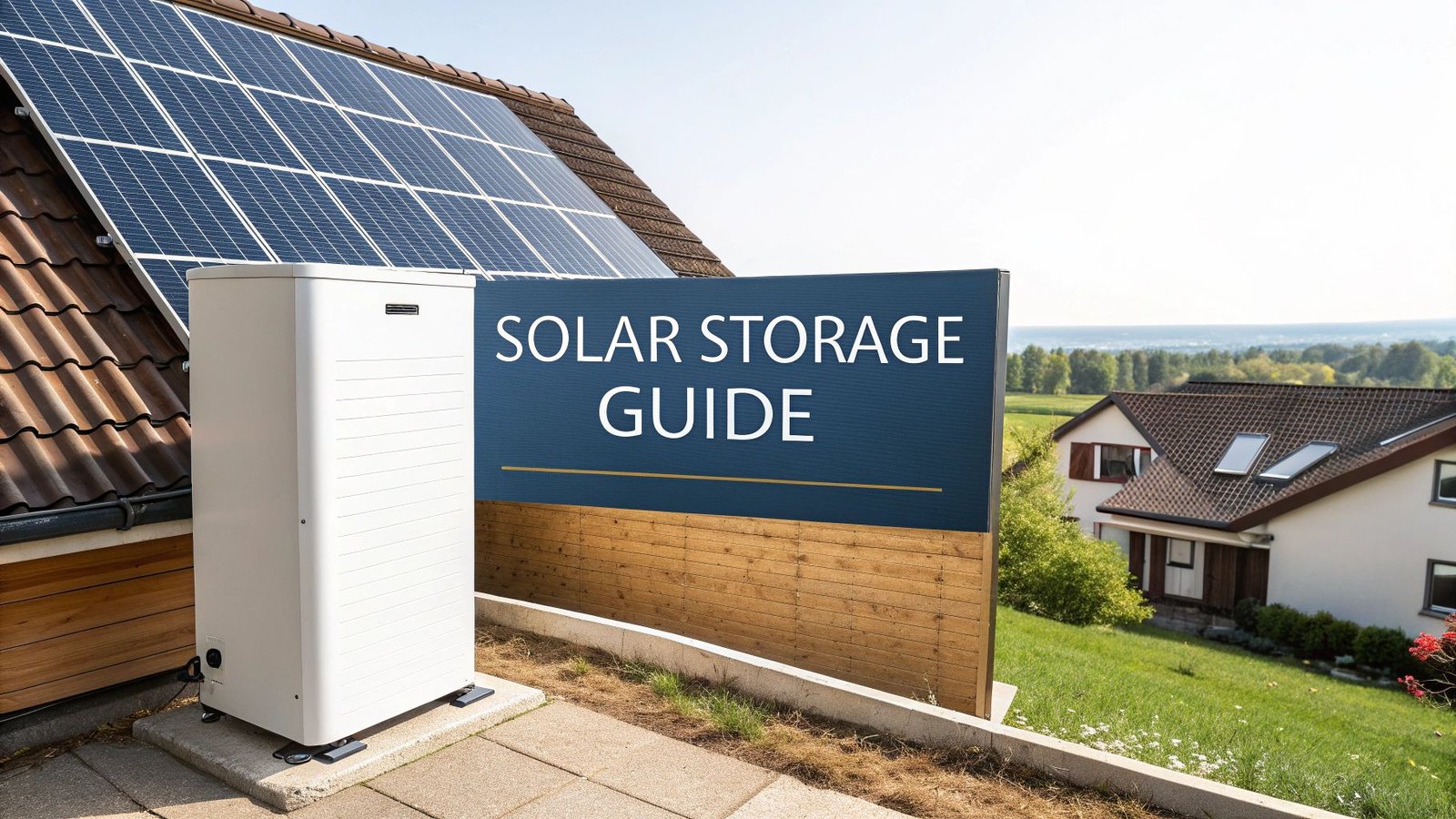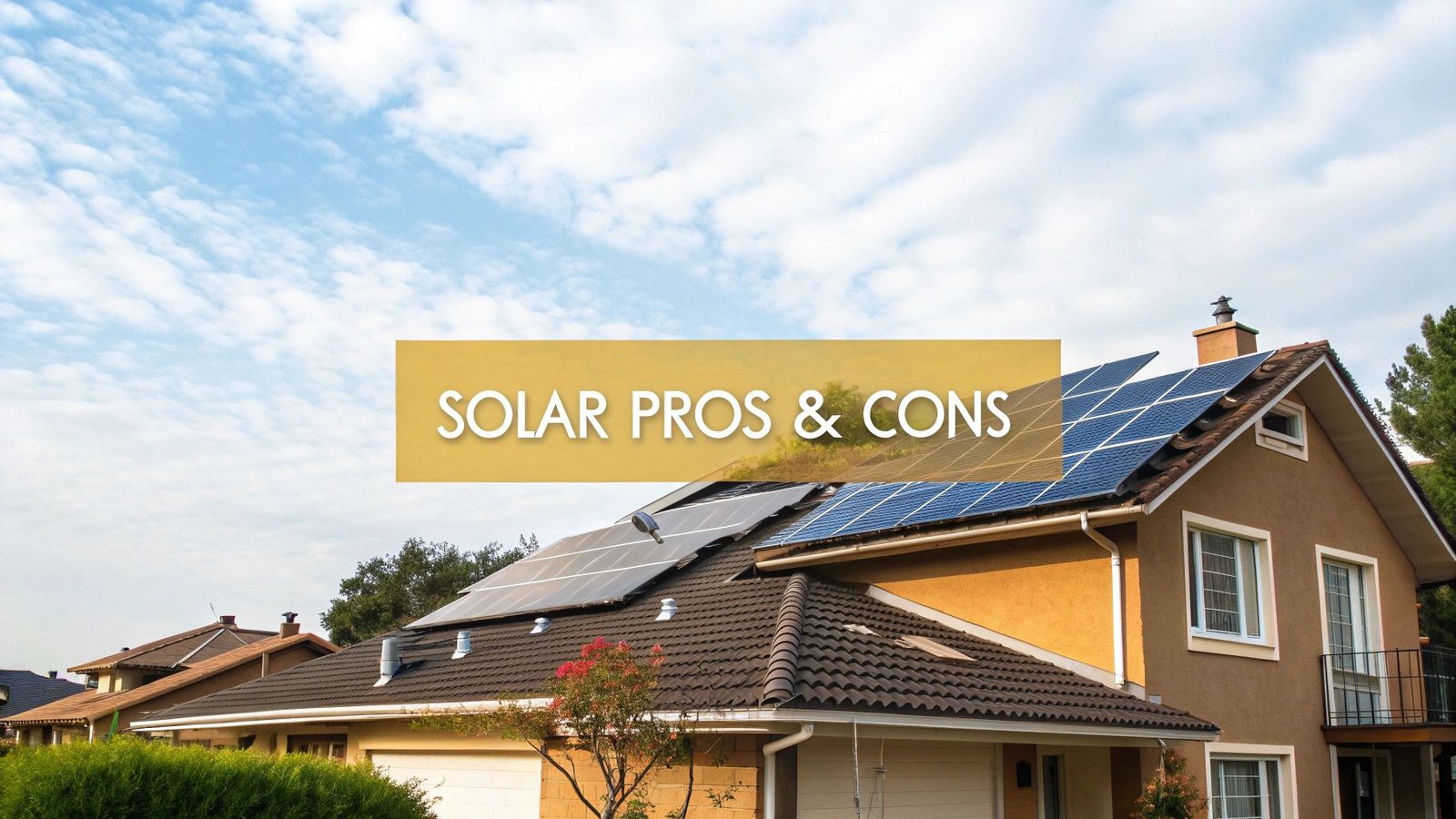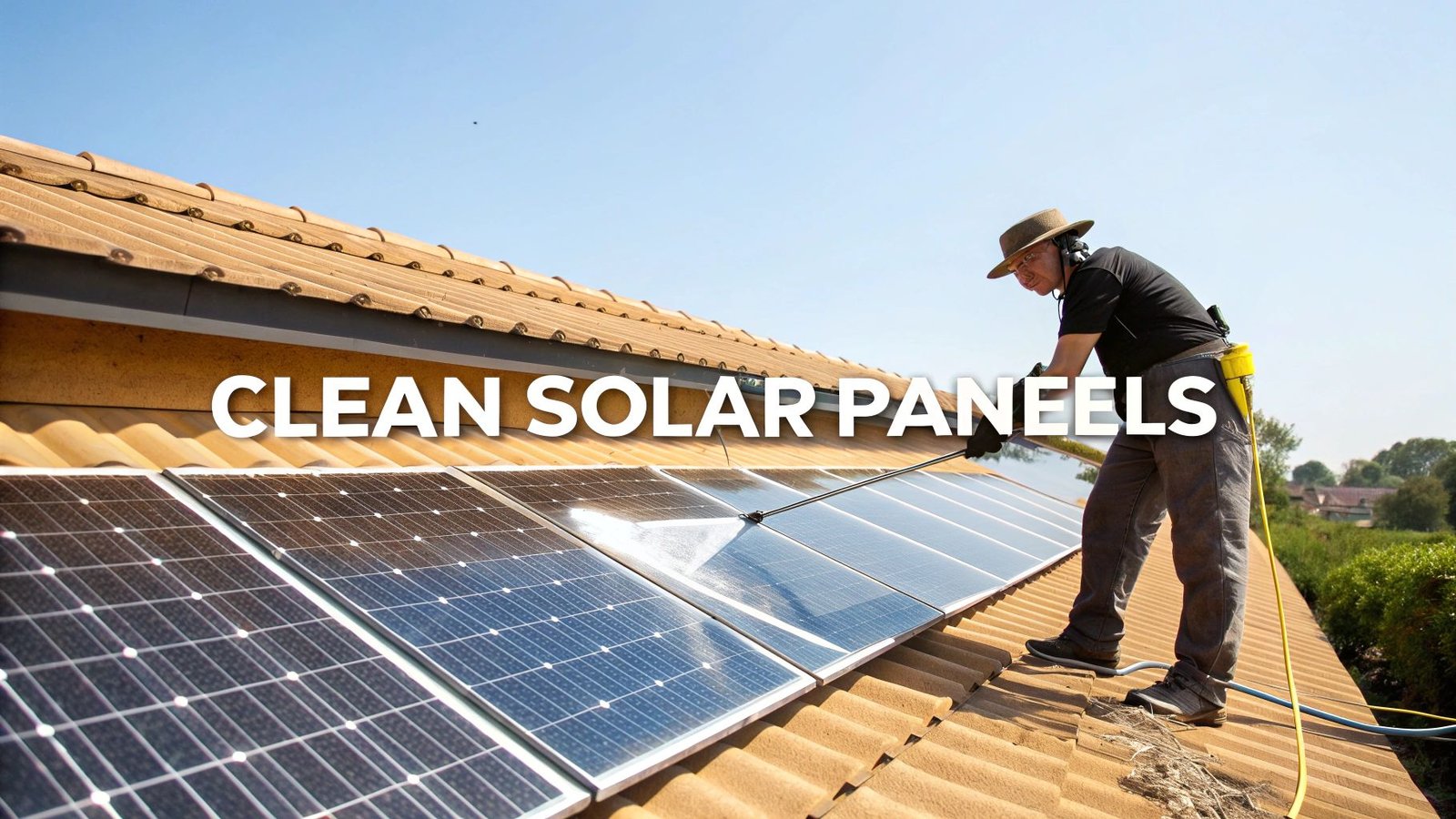So, you're thinking about getting solar energy for my home. It's a big decision, and the first question everyone asks is the same: is it actually worth it? The answer really comes down to three things: your roof's condition, how much sun it gets, and what you're currently paying for electricity. Nailing down these details is the first step to figuring out if solar is a smart financial move for you.
Is Solar Power the Right Move for Your Home?

Before you start getting quotes and diving into the technical jargon, it's a good idea to do a quick gut check on your own property. Think of it as a pre-qualification step. This isn't about getting lost in the weeds; it's about seeing if your home is a solid candidate for solar in the first place.
The reality is that not every house is a perfect fit. A home in the suburbs with a big, south-facing roof that's clear of trees is pretty much a dream scenario for an installer. On the other hand, a city townhouse stuck in the shadow of a high-rise might never generate enough power to make the investment pay off.
Key Factors to Assess
To get started, let's look at the foundational elements you need to consider.
- Sunlight Exposure (Solar Access): This is the big one. Your roof needs to get several hours of direct, unblocked sunlight every day. The sweet spot is generally between 9 a.m. and 3 p.m.
- Roof Condition and Orientation: First, is your roof in good shape? If you'll need a new one in the next few years, it's best to do that before installing panels that are meant to last 15-20 years. In the Northern Hemisphere, a south-facing roof is ideal, but east and west-facing roofs can work well, too.
- Your Current Electricity Bills: The more you're paying now, the more you stand to save. If your monthly bill is consistently creeping over $100, the financial argument for solar becomes much stronger.
The Growing Appeal of Home Solar
People are more interested than ever in gaining some energy independence, and residential solar is a huge part of that conversation. Even as the market ebbs and flows, the core appeal remains. A 2022 survey revealed that 59% of people who don't have solar would probably consider it in the near future.
And what about those who've already made the switch? Homeowner satisfaction is incredibly high—over 80% of solar owners say they'd recommend it to friends and family. You can dig into some of these consumer trends on McKinsey.com.
Here’s a simple pro tip: Take a walk around your property on a sunny day during those peak hours. See where the shadows fall from trees, chimneys, or your neighbor's house. This quick, real-world check can tell you a lot about your home's solar potential before you ever pick up the phone to call an installer.
How to Figure Out Your Home's Energy Needs
Before you even start looking at solar panels, you need a solid grasp of your home's unique energy appetite. It's the only way to know what you’re trying to solve. The best way to do this is to look back at your past energy use, and your old electricity bills are the perfect place to start.
You'll want to gather your utility bills from the last 12 meses. Don't just grab one or two—you need the full year to see the whole story. Your energy use in July, with the AC blasting, is going to look a lot different than it does in a mild April. Seeing those seasonal peaks and valleys is essential.
Digging Into Your Electricity Bills
Once you have the bills in hand, hunt for one specific number: your monthly kilowatt-hour (kWh) usage. This is the unit that measures how much electricity your home actually consumed. Most utility bills these days include a handy chart showing your usage over the past year, which saves a lot of time.
Let's walk through a typical family's usage to see how this works in the real world.
- Winter (Nov-Feb): They average about 600 kWh a month, thanks to heating and having the lights on longer.
- Spring/Fall (Mar-May, Sep-Oct): Usage dips to a more modest 450 kWh per month.
- Summer (Jun-Aug): Things really ramp up, spiking to 900 kWh a month with the A/C and pool pump running full tilt.
%20over%20a%20year.%20The%20y-axis%20is%20kWh%20and%20x-axis%20is%20months.%20Show%20a%20peak%20in%20summer%20(around%20900%20kWh),%20a%20dip%20in%20spring/fall%20(450%20kWh),%20and%20a%20mid-level%20in%20winter%20(600%20kWh),%20with%20clean,%20modern%20design.)
Add it all up, and this family uses about 7,800 kWh annually, which comes out to an average of 650 kWh per month. That annual number, 7,800 kWh, is the rock-solid baseline you'll use to start sizing a solar system.
Don't Forget to Plan for the Future
Your past usage is a great starting point, but what's changing? Your life isn't static, and your energy needs probably aren't either. Think about any big purchases or lifestyle changes on the horizon.
Here are a few common game-changers:
- Electric Vehicle (EV): This is a big one. Charging an EV at home can easily add 2,000 to 4,000 kWh (or more!) to your annual consumption.
- New Heat Pump: If you're swapping a gas furnace for an all-electric heat pump, your electricity usage will obviously climb.
- Swimming Pool or Hot Tub: These are notorious energy hogs and need to be factored into your total.
If our example family is planning to buy an EV next year, they should probably tack on another 3,000 kWh to their total. Suddenly, their target isn't 7,800 kWh anymore—it's 10,800 kWh. Sizing a system for this future need from the get-go is far smarter than realizing you're short on power and needing to add more panels down the road.
A great first step, even before calculating, is finding ways to trim your current usage. You can learn more about effective home energy conservation improvements.
Turning kWh into a System Size (kW)
So, how do you translate that big annual kWh number into an actual solar system size? Solar systems are measured in kilowatts (kW), which is a measure of their peak power output. To figure this out, you need to know how many "peak sun hours" your specific location gets on an average day.
Let's say your home gets an average of 4.5 peak sun hours per day. The math is pretty straightforward:
- System Size in kW = (Your Annual kWh Usage / 365 days) / Your Daily Peak Sun Hours
Plugging in our family's future need of 10,800 kWh:
(10,800 kWh / 365) / 4.5 = 6.57 kW
This tells them they should be looking for a system right around 6.6 kW to cover 100% of their expected electricity needs. The chart below gives you an idea of what the investment and return can look like.

As you can see, while there's an upfront cost, the long-term savings often result in a very reasonable payback period.
A Quick Pro Tip: You don't always need to offset 100% of your power. Sometimes, a system that covers 80-90% of your needs delivers a better return on your investment, especially if your local utility's net metering policies aren't great.
The ultimate goal is to find that perfect balance between how much energy you can produce, the roof space you have available, and what fits your budget. A professional installer will fine-tune these numbers based on your roof's angle and any potential shading, but doing this homework first puts you in the driver's seat. You’ll walk into those conversations knowing exactly what your home really needs.
Choosing the Right Solar Panels and Hardware

Alright, you’ve figured out how much power you need. Now comes the exciting part: picking the gear that will actually make it happen. Getting a handle on the technology behind solar energy for my home can feel a bit overwhelming, but it really just comes down to a few key pieces of equipment.
Knowing what your installer is quoting you is the key to making a smart decision you'll feel good about for years to come.
The solar panels are obviously the star of the show, and there are a few different kinds you'll run into. The type you pick has a direct impact on your system's output, especially if you're working with limited roof space.
Decoding Solar Panel Types
It’s important to know that not all solar panels are created equal. You’ll mainly see three types in your quotes: monocrystalline, polycrystalline, and thin-film. Each has its own strengths, and for most homeowners today, the decision really boils down to efficiency versus cost.
-
Monocrystalline Panels: These are those sleek, uniform black panels you see on a lot of modern homes. They’re made from a single, pure silicon crystal, which makes them the most efficient option on the market, usually hitting between 19% to 22.5% efficiency. Higher efficiency means more power from a smaller area, making them perfect for homes with small roofs or tricky shading where you need to maximize every square foot.
-
Polycrystalline Panels: You can spot these by their distinctive blue, marbled look. They're made by melting multiple silicon fragments together, a process that makes them a bit less efficient but also more affordable. If you’ve got a big, sunny roof without any obstructions and want to keep initial costs down, a fantastic, practical choice.
-
Thin-Film Panels: While you won't see these on many houses, thin-film panels are super lightweight and flexible. Their lower efficiency means you need a much larger area to generate the same amount of power, so they're typically reserved for large commercial buildings or other unique projects.
In my experience, the choice often comes down to a simple trade-off. Got a small roof? You’ll want to invest in high-efficiency monocrystalline panels. Have plenty of space to work with? A budget-friendly polycrystalline setup could give you a much better return on your investment.
To make this crystal clear, here’s how the main options stack up.
Comparación de tecnologías de paneles solares
When you're looking at quotes, this table can help you quickly understand the pros and cons of the most common residential solar panel types.
| Tipo de panel | Gama de eficiencia | Average Cost | Lo mejor para |
|---|---|---|---|
| Monocristalino | 19% – 22.5% | Más alto | Small roofs or maximizing power output in a limited space. |
| Policristalino | 15% – 18% | Baja | Large, unobstructed roofs where budget is a primary concern. |
| Capa fina | 10% – 13% | Varía | Commercial or specialized applications; rarely for homes. |
This is just a quick overview, of course. For a deeper dive into panel specs and brands, you can learn exactly cómo elegir paneles solares in our comprehensive guide.
The Critical Role of Inverters
So, your panels are soaking up the sun and generating direct current (DC) electricity. That's great, but your home's appliances run on alternating current (AC). The inverter is the unsung hero of your system, the piece of hardware that handles this crucial conversion.
The inverter you choose has a huge impact on your system’s overall performance and how you can monitor it. For residential systems, you'll be looking at two main options: string inverters and microinverters.
A inversor monofásico is the tried-and-true workhorse. With this setup, your panels are wired together in a series (a "string"), and they all send their power to one central inverter box. It's a simple and cost-effective approach that works beautifully if you have a straightforward roof that gets consistent sun all day long. The only catch? If one panel's performance dips—maybe from a passing cloud or some fallen leaves—it brings down the output of the entire string to match that weakest link.
Por otro lado, microinverters are a more modern, sophisticated solution. Instead of one big box, a small microinverter is installed under each and every panel. This means each panel becomes its own mini power plant, converting DC to AC right on the roof. If one panel gets shaded, the others keep chugging along at full power. This makes them the go-to choice for complex roofs with different angles, dormers, or pesky trees. Plus, they let you track the performance of every single panel, which is a game-changer for troubleshooting.
Ultimately, the right hardware comes down to the specifics of your home—your roof's layout, your local weather, and of course, your budget. With this knowledge in hand, you can walk into any conversation with an installer, ask the right questions, and be confident you’re getting a system built for the long haul.
Navigating Solar Incentives and Financing
The sticker price on a solar quote is almost never what you actually end up paying. The real cost comes into focus once you understand the landscape of incentives and financing, and this is where things get interesting. Think of this as your financial roadmap—the key to unlocking huge savings and making solar an incredibly smart investment for your home.
The Big One: The Federal Tax Credit
Let's start with the most powerful tool in the solar affordability toolbox: the Residential Clean Energy Credit. Most people just call it the federal solar tax credit, or ITC.
This isn't just a simple discount. It's a dollar-for-dollar credit that directly reduces what you owe on your federal taxes. For any system installed between 2022 and 2032, the credit is a whopping 30% of your total system cost, and there's no cap.
So, what does that look like in the real world? If your total solar installation comes to $20,000, the federal tax credit shaves $6,000 right off your tax liability. That’s a massive reduction in the net cost of your system before you even consider anything else.
Don't Forget to Look Local
While the federal credit gets all the headlines, you'd be surprised what you can find right in your own backyard. Many homeowners miss out on valuable incentives offered at the state and local levels. It's definitely worth doing a little digging.
Keep an eye out for programs like:
- Créditos fiscales estatales: Some states sweeten the deal with their own tax credits, which you can stack on top of the federal one.
- Reembolsos en efectivo: Your local utility or city might offer a direct cash rebate based on your system's size. It’s free money.
- Property Tax Exemptions: In many places, the value a solar system adds to your home is completely exempt from property taxes.
How Net Metering Pays You Back
Beyond these upfront savings, net metering is the policy that keeps your investment paying off year after year. It’s the billing system that lets you send any extra electricity your panels produce back to the grid. The utility then gives you a credit for that power.
The value of that credit can vary a lot. Some utilities offer "full-retail" net metering, crediting you at the same rate they charge you for electricity. Others have less generous policies, which can change how quickly your system pays for itself.
The global push for solar has created a dynamic environment for these kinds of financial incentives. Today, over 7.3 million homes in the United States are powered by solar, and homeowners are often cutting their energy costs by 20% to 50%. With average system costs running between $10,290 to $20,580, that 30% federal tax credit is crucial for making the numbers work for so many families.
Finding the Right Way to Pay
After you've accounted for every available incentive, it's time to decide how you'll pay for the system itself. Each option has a very different impact on your long-term return on investment.
Cash Purchase
Paying upfront in cash always delivers the biggest long-term savings. Simple as that. You own the system outright from day one, you get all the tax credits and rebates yourself, and you have zero monthly payments or interest to worry about.
Solar Loans
A solar loan is the most popular route for a reason—it lets you own your system without draining your savings. You still get all the tax benefits, and your fixed monthly loan payment is often less than what you were paying the utility company. That means you start saving money immediately. If you're looking at home equity, you might want to compare HELOAN and HELOC options to see what fits your financial picture best.
Solar Leases & Power Purchase Agreements (PPAs)
With a lease or a PPA, a third-party company installs their solar panels on your roof, and you just pay them a fixed monthly rate for the power. It's usually cheaper than the utility's rate and requires little to no money down. The catch? The company owns the system, so they get all the tax credits and rebates, not you. To get into the nitty-gritty, you can learn more about the differences between solar leasing vs. a PPA in our dedicated article.
Ultimately, there's no single "best" path. It all comes down to your personal finances and what you want to achieve. By understanding how to pull these levers—from tax credits to financing—you can make a decision that brings clean energy and fantastic financial returns to your home for decades to come.
What to Expect During Solar Installation

So, you've signed the contract and are ready to go solar. This is where the real work begins. While the crew might only be on your roof for a day or two, getting to that point involves a carefully coordinated series of steps, from final designs to navigating local bureaucracy.
Knowing what's coming helps manage expectations and makes the whole experience much smoother. It’s exciting to see your decision to get solar energy for my home finally take shape, and a good professional team will make the process feel practically seamless.
From Blueprint to Power Plant
The first thing that happens after you commit is a detailed site survey. A technical team will visit your home to get the hard data they need—they'll take precise roof measurements, check out its structural condition, and inspect your main electrical panel. This isn't just a quick once-over; they're gathering the exact information needed for the official engineering blueprints.
These blueprints are the key to the next, and often longest, phase: permitting. Your installer submits these plans to your local city or county for approval. Depending on where you live, this waiting game can take anywhere from a few weeks to a couple of months.
Insider Tip: Ask your installer about the typical permit turnaround time in your specific town. An experienced local company will have a great feel for how quickly the local building department moves on solar projects.
The Big Day: Installation
Once the permits are in hand, it's time for the main event. An installation crew will arrive, usually early in the morning, to get your system built. For a standard residential project, the whole on-site job is usually done in just one or two days.
Here's how it typically unfolds:
- First, the crew sets up safety gear like harnesses and anchors to work securely on the roof. They’ll also mark out the precise layout for the mounting hardware.
- Next, they install the racking system. These metal racks are bolted directly into your roof rafters and sealed with heavy-duty flashing to make everything completely watertight.
- While some crew members are on the roof, others will run the electrical conduit that connects your panels to the inverter and, ultimately, to your home's main electrical panel.
- Finally, the panels themselves are brought up, locked into the racks, and wired together.
Final Steps to Activation
Even with a roof full of shiny new panels, you can't start generating power just yet. First, your system has to pass a final inspection from a local building official. They'll come out to verify that the work matches the approved plans and meets all safety codes.
After that green tag from the inspector, the last hurdle is getting "Permission to Operate" (PTO) from your utility company. They’ll often come and swap out your old electric meter for a new net meter, which can track power flowing both ways. Once you have that official PTO, you can flip the switch and start producing your own clean energy.
After your solar installation is finished, it’s a good idea to give your insurance provider a call about the upgrade. Check out these other life changes to tell your insurance agent about to make sure your policy is up to date.
Thankfully, modern solar systems are built tough and need very little maintenance. Just keep an eye on your system's performance via its monitoring app, and you can expect it to run efficiently for the next 25 años o más.
Got Solar Questions? Let's Clear Things Up.
Making the leap to solar is a big decision, and it’s completely normal to have some questions, even after you’ve done your homework. I've heard them all over the years. Let's walk through some of the most common ones I get from homeowners, so you can feel confident about your next steps.
How Long Do Solar Panels Actually Last?
This is probably the number one question on everyone’s mind. The short answer? A very long time. Today's solar panels are incredibly durable. Reputable manufacturers back their products with performance warranties of De 25 a 30 años, and these things are built to handle tough weather, from blistering heat to heavy snow and hail.
Now, their output does decline slightly over time—it's a process called degradation—but they don't just switch off after 25 years. A quality system that’s been looked after will keep producing clean energy for your home well beyond its warranty period. Think of it as a long-term, reliable power plant on your roof.
Will Solar Panels Really Increase My Home's Value?
Yes, they absolutely do. Study after study confirms that homes with an owned solar panel system sell for a premium. Put yourself in a buyer's shoes for a moment: you're not just buying a house; you're buying a home that comes with dramatically lower, predictable energy bills for the foreseeable future. That’s a huge selling point.
The exact boost in value depends on your location and the size of your system, but the promise of a smaller carbon footprint and real monthly savings gives your home a serious edge on the market.
Here's a pro tip: The real value comes from owning the system, whether you paid cash or used a solar loan. Leased systems are a different story and usually don't add the same equity, as the new owner has to agree to take over the lease payments.
The chart below shows how the investment can pay off, both in what you save and the equity you build.
What Happens If the Power Goes Out?
This is a big one, and there's a lot of confusion around it. A standard grid-tied solar system will automatically shut down during a utility outage. It’s a mandatory safety feature to protect utility workers who are making repairs—you can't have your panels sending power into lines they think are dead.
If you want to keep your lights on when the grid goes dark, you’ll need a battery. Pairing your panels with a solar battery allows you to store the extra power you generate during the day. When an outage hits, you can draw from that stored energy to run your essential appliances, giving you true energy independence.
This desire for energy security is a huge driver in the market. In the first quarter of 2025, the U.S. residential solar market installed a massive 1,106 MWdc of capacity. Even with that growth, residential solar penetration is still below 10% in the U.S., which points to a ton of room for growth. Experts are projecting an average annual growth of 9% between 2025 and 2030, largely because of rising electricity costs and homeowners wanting more control. You can dig into more of these market trends on seia.org.
Getting these key questions answered is the foundation for making a smart decision. When you understand the lifespan, financial impact, and outage performance of a solar system, you're in a much better position to know if it’s the right move for you.
Ready to see what solar could look like for your home? The team at Energía radiante can put together a custom quote and answer any other questions you have. Start your journey to energy independence today.



'%20and%20the%20other,%20larger%20slice%20is%20'70%25%20Net%20Cost%20($14,000)',%20with%20a%20clean,%20minimalist%20design.)
%20next%20to%20the%20average%20payback%20period%20(e.g.,%20a%20bar%20showing%208-12%20years),%20with%20clean%20icons%20and%20a%20neutral%20background)


